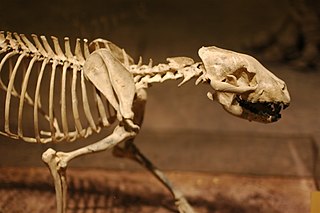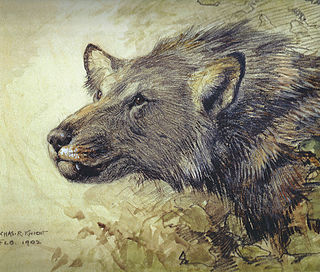
Canidae is a biological family of dog-like carnivorans, colloquially referred to as dogs, and constitutes a clade. A member of this family is also called a canid. There are three subfamilies found within the canid family, which are the extinct Borophaginae and Hesperocyoninae, and the extant Caninae. The Caninae are known as canines, and include domestic dogs, wolves, coyotes, foxes, jackals and other extant and extinct species.

Amphicyonidae is an extinct family of terrestrial carnivorans belonging to the suborder Caniformia. They first appeared in North America in the middle Eocene, spread to Europe by the late Eocene, and appear in Asia, and Africa by the early Miocene. They had largely disappeared worldwide by the late Miocene, with the latest recorded species at the end of the Miocene in Pakistan. They were among the first carnivorans to evolve large body size. Later in their history, they came into competition with hesperocyonine and borophagine canids. As dogs evolved similar body sizes and cranial and dental adaptations, the rise of these groups may have led to their extinction. Amphicyonids are often colloquially referred to as "bear-dogs".

Borophagus is an extinct genus of the subfamily Borophaginae, a group of canids endemic to North America from the Middle Miocene epoch through the Early Pleistocene epoch 12—1.8 Mya.

Aelurodon is an extinct canid genus of the subfamily Borophaginae which lived from the Barstovian land mammal age of the middle Miocene to the late Miocene epoch. Aelurodon existed for approximately 10.7 million years.

The extinct Borophaginae form one of three subfamilies found within the canid family. The other two canid subfamilies are the extinct Hesperocyoninae and extant Caninae. Borophaginae, called "bone-crushing dogs", were endemic to North America during the Oligocene to Pliocene and lived roughly 34—2.5 million years ago, existing for about 33.5 million years.

Epicyon is a large, extinct, canid genus of the subfamily Borophaginae, native to North America. Epicyon existed for about 15 million years from the Hemingfordian age of the Early Miocene, to the Hemphillian of the Late Miocene. Epicyon is the largest known canid of all time, with the type species reaching 2.4 m (7.9 ft) in length, 90 cm (35 in) in shoulder height and approximately 100–125 kg (220–276 lb) in body mass. The largest known humerus specimen belonged to an individual weighing up to 170 kg (370 lb).

Amphicyon is an extinct genus of large carnivorous bone-crushing mammals, popularly known as bear dogs, of the family Amphicyonidae, subfamily Amphicyoninae, from the Burdigalian Epoch until the late Pliocene. Members of this family received their vernacular name for possessing bear-like and dog-like features. They ranged over North America, Europe, Asia, and Africa from 16.9 to 2.6 Ma ago, existing for approximately 14.3 million years.

Agriotherium is an extinct genus of bears whose fossils are found in Miocene through Pleistocene-aged strata of North America, Eurasia, and Africa. This long-lived genus persisted from at least ~11.6–2.5 Mya. Materials from the late-surviving A. africanum in Africa have suggested that A. africanum died out during the early Gelasian.

Phlaocyon is an extinct genus of the Borophaginae subfamily of canids native to North America. It lives from the Early Oligocene to the Early Miocene epoch 33.3–16.3 Mya, existing for approximately 17.3 million years. It is closely related to Cynarctoides.

Simocyon is a genus of extinct carnivoran mammal in the family Ailuridae. Simocyon, which was about the size of a mountain lion, lived in the late Miocene and early Pliocene epochs, and has been found in Europe, Asia, and rarely, North America and Africa.

Cynarctus is an extinct genus of the Borophaginae subfamily of canids native to North America. The genus was first founded by W. D. Matthew in 1901, based from a pair of lower jaws, Cynarctus saxitilis, found in the Pawnee Creek Beds of Colorado. It lived during the Middle to Late Miocene 16.0—10.3 mya, existing for approximately 5.7 million years. Fossils have been uncovered in Colorado, California, Maryland, western Nebraska, and Texas. It was likely an omnivore, and lacked the bone-cracking adaptations found in some later borophagines. Newer findings have proved the genus to be described as a large dog-like raccoon, a result from combining characteristics from Canidae with Procyonidae.

Enhydrocyon is an extinct genus of bone crushing canid which inhabited North America during the Oligocene and Early Miocene, 30.8—20.4 Ma, existing for approximately 11 million years.

Desmocyon is an extinct genus of the Borophaginae subfamily of canids native to North America. It lived from the Late Oligocene to the Early Miocene, 24.8—16.3 Mya, existing for approximately 8.5 mya. It is a rarely found genus, with fossil deposits only occurring in western Nebraska, Wyoming, New Mexico and north Florida. It is regarded as a primitive, transitional member of the Borophagini tribe.

Microtomarctus is an extinct monospecific genus of the Borophaginae subfamily of canids native to North America. It lived during the Early to Middle Miocene, and existed for approximately 7 million years. Fossil specimens have been found in Nebraska, coastal southeast Texas, California, New Mexico, Nevada and Colorado. It was an intermediate-size canid, and more predaceous than earlier borophagines.
Borophagus dudleyi is an extinct species of the genus Borophagus of the subfamily Borophaginae, a group of canids endemic to North America from the late Hemphillian of the Miocene epoch through the Pliocene epoch. Borophagus dudleyi existed for approximately 5.4 million years.

Borophagus hilli is an extinct species of the genus Borophagus of the subfamily Borophaginae, a group of canids endemic to North America from the Late Miocene until the Pliocene.

Borophagus diversidens is an extinct species of the genus Borophagus of the subfamily Borophaginae, a group of canids endemic to North America from the late Miocene epoch through the Pliocene epoch 4.9—1.8 Ma.
Borophagus pugnator is an extinct species of the genus Borophagus of the subfamily Borophaginae, a group of canids endemic to North America from the early Miocene epoch through the late Miocene epoch 23.3—5.3 Ma. Borophagus pugnator existed for approximately 18 million years.
Borophagus secundus is an extinct species of the genus Borophagus of the subfamily Borophaginae, a group of canids endemic to North America from the Early Miocene epoch through the Late Miocene epoch. Borophagus secundus existed for approximately 17.7 million years.

Eucyon is an extinct genus of medium omnivorous coyote-like canid that first appeared in the Western United States during the late Middle Miocene 10 million years ago. It was the size of a jackal and weighed around 15kg. Its species E. zhoui was one of a number of North American mammals which invaded East Asia around 5–6 million years ago, followed by the genus going extinct 3 million years ago. This genus is proposed to have given rise to genus Canis 6 million years ago.


















